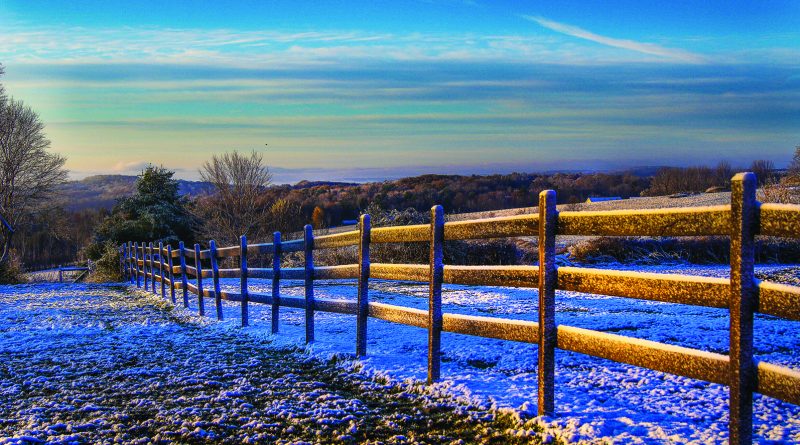When Winter Comes—An Essay By Donald Hall
Donald Hall is the former poet laureate of the United States. Excerpted from “Why We Live Here,” from Here at Eagle Pond, by Donald Hall, copyright 1990. Reprinted by permission of Houghton Mifflin Harcourt.
We know ourselves by winter. For some of us the first true snow begins it; for others winter begins with the first bruising assault of zero weather.
There is yet another sort, light-lovers, for whom winter begins with dark’s onset in mid-August. If we wake as we ought to at 5:30, we begin waking in darkness. Some of us, on the other hand, cherish the gradually increasing dark, which we wrap around ourselves in the prosperous warmth of woodstove, oil, electric blanket, storm window, and insulation.
Often October has shown one snow flurry, sometimes even September. For that matter, it once snowed in New Hampshire every month of the year. In 1816 it snowed and froze in June, in July, in August—the Poverty Year, season of continuous winter, when farmers planted over and over again, over and over again ripped out frozen shoots of corn and pumpkin. An 1815 volcanic eruption in Indonesia did it—though at the time our preachers thought the source more local and divine wrath explicit.
Winter starts in November, whatever the calendar says, with gray of granite, with russet and brown of used leaves. In November stillness our stonewalls wait, attentive, and gaunt revenant trunks of maple and oak settle down for winter’s stasis, which annually mimics and presages death for each of us and for the planet. November’s palette, Braque’s analytic Cubism, squared with fieldstones, interrupts itself briefly with the bright-flapped caps of deer hunters and their orange jackets. Always it is modified by the black-green fir, enduring, hinting at permanence. Serious snow begins one November afternoon.
South of us Mount Kearsarge gradually disappears into white gauzy cloud, vanishing mountain, weather-sign for all of us to its north. For one hundred and eighty years the people of this house have looked south at dawn’s light and again at sunset to tell the coming weather, reliable in 1803 when the first builder put in the south windows and reliable still. When Kearsarge disappears the storm comes closer. Birds gather at the feeder, squabbling, gobbling their weight. When they are full they look for shelter, and we do the same, or at least we bring wood from the shed to stack beside the old Glenwoods and the new Jøtul.
Every year the first snow sets me dreaming. By March it will only bring the grumps, but November snow is revenance, a dreamy restitution of childhood or even infancy. Tighten the door and settle a cloth snake against the breeze from the door’s bottom; make sure the storms are firmly shut; add logs to the stove and widen the draft. Sit in a chair looking south into blue twilight that arrives earlier every day — as the sky flakes and densens, as the first clear flakes float past the porch’s wood to light on dirt of the driveway and on brown frozen grass or dry stalks of the flower border.
They seem tentative and awkward at first, then in a hastening host a whole brief army falls, white militia paratrooping out of the close sky over various textures, making them one. Snow is white and gray, part and whole, infinitely various yet infinitely repetitious, soft and hard, frozen and melting, a creaking underfoot and a soundlessness. But first of all it is the reversion of many into one. It is substance, almost the idea of substance, that turns grass, driveway, hayfield, old garden, log pile, Saab, watering trough, collapsed barn, and stonewall into the one white.
We finish early in November the task of preparing the house for snow—tacking poly over the low clapboards, raking leaves against the foundations as high as we can rake them. When the first real snow arrives, no dusting half inch but a solid foot, we complete the insulation, for it is snow that keeps us warm.
After a neighbor’s four-wheel-drive pickup, plow bolted in front, swoops clean our U-shaped driveway, and after we dig out the mailbox for Bert’s rural delivery, it is time to heap the snow over leaves and against poly, around the house, on all sides of the house, against the granite foundation stones. Arctic winds halt before this white guard. When bright noon melts inches of snow away from the house, reflecting heat from the snowy clapboard, it leaves cracks of cold air for us to fill when new snow falls all winter long.
But November, although it begins winter, is only winter’s approach, with little snow and with cold that announces itself only to increase. The calendar’s winter begins at the solstice, Advent’s event: the birth of the child who rises from winter to die and rise again in spring. November is autumn’s burial, and the smoke of victims sacrificed is thanks for harvest and magic as we go into ourselves like maples for winter’s bear-sleep. We make transition by way of feast and anticipatory snow, toward the long, white, hard hundred days, the true winter of our annual deaths.
We wait for December to feel the cold, I mean cold, for longer than a week, but now we are ready for snow.




Pingback: Vermont Sports Magazine, November-December 2017